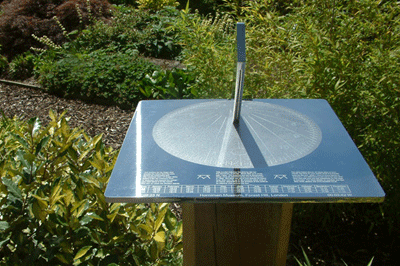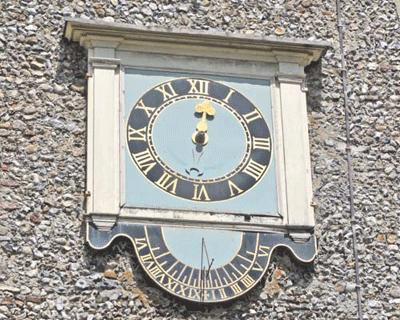The history of sundials
Man has been measuring the path of the sun since pre-history. Sundials are a fascinating part of this.

The history of man's measurement of time goes far further back than any written records. People have always observed that the shadow of an object goes round during the day, that the shadow is longer in the winter than in the summer, and knowledge of the solstices in June and December, and of the equinoxes in March and September, goes back to pre-history.
There are monuments all over the world which are aligned to mark the solstices. For example, the 4,000 year old Maes Howe monument in Orkney is aligned so that, at sunset on Midwinter's Day, the sun exactly shines down a long narrow tunnel and on to the back wall of the large chamber.
Building such a monument requires a settled society with highly specialised experts in astronomy and other subjects, and considerable agricultural surpluses to have the labour to build them. Are they sundials? I would argue that they are, and I would base my case on the changing nature of time.
People then did not need to know whether it was nine or ten o'clock. Their vital concern was whether it was time to plant the crops. The Anastazi in New Mexico had a neat way of marking this.

* Subscribe to Country Life and save over £50 a year
Since the sun rises slightly more to the east every day in spring, they waited till the sun rose just between two peaks on the skyline, and knew that it was then time to start planting.
At some point, probably slightly over 2000 years ago, people started measuring divisions of the day as well as divisions of the year.
Exquisite houses, the beauty of Nature, and how to get the most from your life, straight to your inbox.
Initially, the divisions would have been very broad: morning, afternoon, evening, and night. These broad divisions were sometimes known as "tides" both here in Britain and in Scandinavia. The word survives in our language as ‘eventide' and ‘noontide'.
People then started measuring these divisions with the aid of shadows. These were the first sundials in the modern sense, in that they had a gnomon (the Greek word for indicator) to cast the shadow, and marked lines on a nearby surface to show the measurement.
Some people think the Egyptians had such devices several hundred years earlier, but this is still a matter of debate.
These early sundials typically had gnomons which were either vertical or horizontal. Such sundials are still made, but they are quite difficult to read because the shadow does not fall in the same direction at the same time each day. So these sundials need two sets of lines, one showing the months and the others, crossing the month lines, to show the time of day.
More scientific sundials were developed around the fifteenth century. These relied on the fact that if the gnomon is at the same angle as the latitude and is also oriented exactly to true north, the shadow will fall in the same direction at the same time each day.
The reason for this is that the angle of the gnomon compensates for the sun's apparent movement from 23.5 degrees above the Equator at the summer solstice, to 23.5 degrees below the equator at the Winter Solstice, and then back again.
In the next two centuries, public clocks became much more widespread, but these clocks were not very accurate, and had to be reset every few days. How do you reset a clock if there are no radio time signals to set it by?
In fact, at this time it was impossible to know what a person in another place thought the time was. So the most practical method was to find out the local time from the sun, either with a sundial or with a noon-mark. This is why there are so many sundials on churches, such as this magnificent example of an integrated clock and sundial from a church in Norfolk.

When the railways came, clocks had become more accurate, and the telegraph enabled the time in one place to be communicated to another. This in itself caused some difficulties, since each community was used to setting the time at noon as 12 o'clock. Thus noon, at say Bristol, would have been 10 minutes later than noon in London, because Bristol is 2.5 degrees west, and the earth rotates at 15 degrees an hour.
So when Mr. Brunel announced that the clocks on Bristol Temple Meads station would be set to London time, there was outrage and many complaints that people keeping Bristol time would miss their trains.
The clock on their Corn Exchange therefore has two hands, one for "railway time" (now GMT) and the other for Bristol time.
Sadly sundials went into a period of decline - few new ones were produced, and many of the old ones were neglected or destroyed. Lately, however, there has been a revival.
The British Sundial Society was founded in 1989, and has compiled a UK register of over 6,500 sundials, and encourages their conservation. The Millennium produced a good crop of new public sundials, including the Tylers and Bricklayers Millennium sundial which I designed on the north side of the Thames near the Millennium footbridge.

The British Sundial Society was founded in 1989, and has compiled a UK register of over 6,500 sundials, and encourages their conservation. The Millennium produced a good crop of new public sundials, including the Tylers and Bricklayers Millennium sundial which I designed on the north side of the Thames near the Millennium footbridge.
Piers Nicholson runs a leading sundial information website www.sundials.co.uk and has also designed an innovative range of spot-on sundials in brass and stainless steel; the range includes horizontal, polar, and equatorial sundials.

This is an article from ProjectBook which provides a wide range of information for the conservation, restoration, care and repair of period and listed buildings. Spot-on Sundials are members of the Products Directory which provides a showcase for specialist products, suitable for use on traditional properties. Updated daily with new content, the website features the heritage register, a products directory, informative articles, current news, events and more. For more information, visit www.projectbook.co.uk.
Country Life is unlike any other magazine: the only glossy weekly on the newsstand and the only magazine that has been guest-edited by His Majesty The King not once, but twice. It is a celebration of modern rural life and all its diverse joys and pleasures — that was first published in Queen Victoria's Diamond Jubilee year. Our eclectic mixture of witty and informative content — from the most up-to-date property news and commentary and a coveted glimpse inside some of the UK's best houses and gardens, to gardening, the arts and interior design, written by experts in their field — still cannot be found in print or online, anywhere else.

